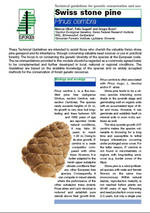Pinus cembra - Technical guidelines for genetic conservation and use for Swiss stone pine
The main strategy of genetic conservation of Swiss stone pine should be a dynamic in situ conservation. However, complementary dynamic or static ex situ conservation may be appropriate in some cases.
In situ conservation can be done within natural forest reserves, in gene conservation units specifically managed for the purpose, as well as in forests managed mainly for other purposes. Generally, abundant and large stands of interfertile autochthonous stone pine trees are best to assure genetic adaptability and adaptedness in the long term. However, small and isolated populations of P. cembra can be of special interest if particular adaptations can be assumed.
Normally, gene conservation can be matched with other goals of the stand management. As many of the P. cembra forests are expected to fulfil protection and/or aesthetic functions, a continuous tree cover is needed. A sufficiently dense, multilayered, uneven-aged forest with a clustered structure meets these demands best. Small-scale silvicultural practices such as the group selection method or the cluster selection method are recommended for both wood production and protection purposes. Where stone pine is naturally mixed with other tree species it is advisable to retain the mixture.
The crucial point in any case for a dynamic in situ gene conservation is the regeneration of the stand. Natural regeneration is considered to be the best way for gene conservation.
If there are suitable germination sites and seed trees within the nutcracker's dispersal range, regeneration of P. cembra occurs naturally. Sometimes a very dense cover of grasses or Alpine roses can be an obstacle for seedling growth, and the removal of patches of this vegetation can be useful. If necessary, animals affecting the young plants have to be excluded or individual protection measures must be taken. Forest gaps smaller in diameter than the height of the surrounding stand tend to accumulate snow during the winter and become snowfree only late in spring. Therefore, the dimensions of regeneration gaps should be 1–4 times the stand height depending on the site conditions.
For artificial regeneration in existing stands or for highelevation afforestations with P. cembra, reproductive material must be chosen carefully owing to extreme site conditions. Only well-adapted and sufficiently variable material originating from similar sites ensures a long-term success for both production and protection purposes. For plantations near the tree limit, the provenance of the material should lie within a 100-metre altitude range relative to the planting site. It is suggested to breed the plants in montane altitudes and to transplant them into a nursery located above 1500 m asl to ensure hardy acclimatization. Direct seeding has proven to be a satisfactory alternative to planting. As a consequence of the erratic seed production and the slow growth process, the planning of a plantation should start well in advance. Seed orchards at lower altitudes containing high-elevation provenances can facilitate a more regular supply of seeds.
Seed orchards can serve as a means of dynamic ex situ conservation of P. cembra if the number of progenies is sufficiently high (at least 50 trees proposed per origin population), especially in the case of endangered small or relic populations. However, it is preferable to conduct dynamic ex situ conservation in the vicinity of the original site and to use the local material. This is what the nutcracker tends to do when it "salvages" the species from accessible spots to rocky outcrops where the seedlings may survive.
Static ex situ conservation of reproductive material of P. cembra for gene conservation purposes is advisable only in case of emergency and the material should be recultivated as soon as possible.
Authors: Marcus Ulber; Felix Gugerli; Gregor Bozič
Journal/Series: EUFORGEN Technical Guidelines for Genetic Conservation and Use
Publication Year: 2004
Publication Format: Folder; PDF
ISBN: 92-9043-619-0
ISBN 13: 978-92-9043-619-5
Language: EN
Pages: 6 p.

